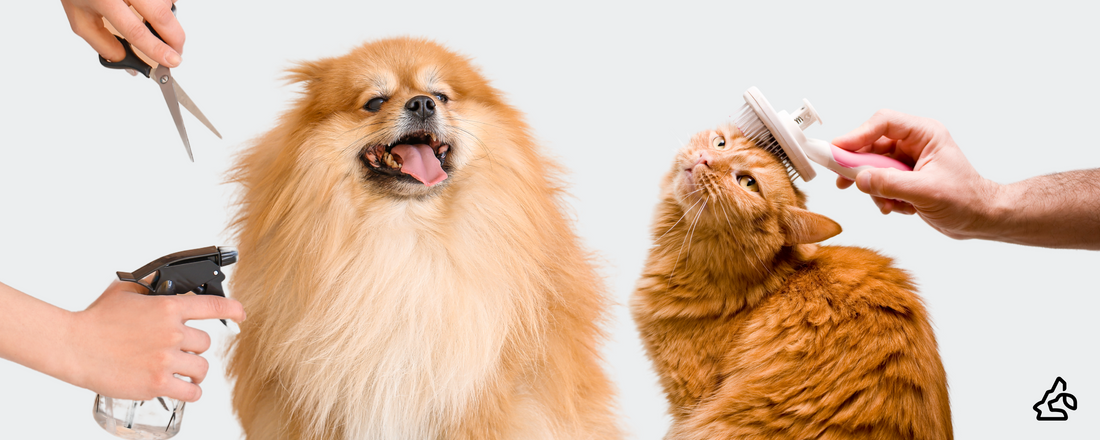As a pet owner, maintaining your pet’s health and well-being involves more than just regular vet visits and a balanced diet. Grooming, parasite control, and proper housekeeping are essential components of pet care that ensure your furry friends are healthy, happy, and comfortable.
This guide will help you understand the importance of these aspects and provide practical tips for effective pet care.
Why Grooming is Important?

-
Hygiene and Cleanliness: Regular grooming helps to keep your pet clean by removing dirt, debris, and loose hair from their coat. This is especially important for preventing skin infections and matting in long-haired breeds.
-
Health Monitoring: Grooming sessions provide an opportunity to check for signs of health issues such as skin problems, parasites, and abnormal growths. Early detection of these issues can lead to prompt treatment and better health outcomes.
-
Comfort and Well-being: Groomed pets are more comfortable and less likely to suffer from matting, skin irritations, and overgrown nails. Regular grooming also reduces shedding, which can help keep your home cleaner.
-
Bonding: Grooming strengthens the bond between you and your pet. It is a time for you to provide care and attention, which can improve your pet’s trust and comfort with you.
Essential Grooming Routines
1. Brushing

- Frequency: Daily for long-haired breeds, and once a week for short-haired breeds.
- Benefits: Removes loose fur, prevents matting, and distributes natural oils throughout the coat.
- Tools: Slicker brush for long-haired breeds, bristle brush for short-haired breeds, and a comb for detangling.
2. Bathing

- Frequency: Every 4-6 weeks, depending on the breed and lifestyle.
- Benefits: Cleanses the coat and skin, removes odors, and reduces shedding.
- Tools: Pet-friendly shampoo and conditioner, and a towel or pet dryer.
3. Nail Trimming

- Benefits: Prevents overgrown nails that can cause pain and mobility issues.
4. Ear Cleaning

- Frequency: Weekly.
- Benefits: Prevents ear infections and removes excess wax and debris.
- Tools: Vet-approved ear cleaning solution and cotton balls.
5. Dental Care

- Frequency: Daily or at least several times a week.
- Benefits: Prevents dental diseases, reduces bad breath, and promotes overall oral health.
- Tools: Pet toothbrush and toothpaste.
6. Eye Cleaning

- Frequency: As needed, especially for breeds prone to tear staining or discharge.
- Benefits: Prevents infections and removes debris from the eyes.
- Tools: Damp cloth or pet-specific eye wipes.
Grooming Different Types of Pets

1. Dogs
- Breeds with Long Hair: Require daily brushing, regular trimming, and frequent bathing.
- Breeds with Short Hair: Require less frequent brushing and bathing but still need regular nail trimming and ear cleaning.
2. Cats
- Short-Haired Cats: Weekly brushing and occasional bathing.- Long-Haired Cats: Daily brushing to prevent matting and regular bathing.
Special Grooming Considerations
1. Seasonal Grooming
- Adjust grooming routines based on the season. For example, more frequent brushing during shedding seasons in spring and fall. 2. Sensitive Areas
- Be gentle when grooming sensitive areas such as the face, ears, and paws. Use appropriate tools and techniques to avoid causing discomfort or injury. 3. Grooming Anxious Pets
- Take a gradual approach to introduce grooming to anxious pets. Use positive reinforcement, treats, and patience to build their comfort level.
Choosing Professional Grooming Services

-
Research: Look for reputable groomers with good reviews and recommendations from other pet owners.
-
Visit the Facility: Ensure the grooming salon is clean and well-maintained. Check the handling and treatment of pets by the staff.
-
Discuss Needs: Communicate your pet’s specific needs and preferences with the groomer. Provide any relevant medical history or concerns.
Regular grooming is essential for maintaining your pet’s health, comfort, and overall well-being. By following the tips and best practices outlined in this guide, you can ensure that your furry friend remains clean, happy, and healthy.
For more detailed information and resources, consider visiting reputable pet care websites and consulting with your veterinarian.



